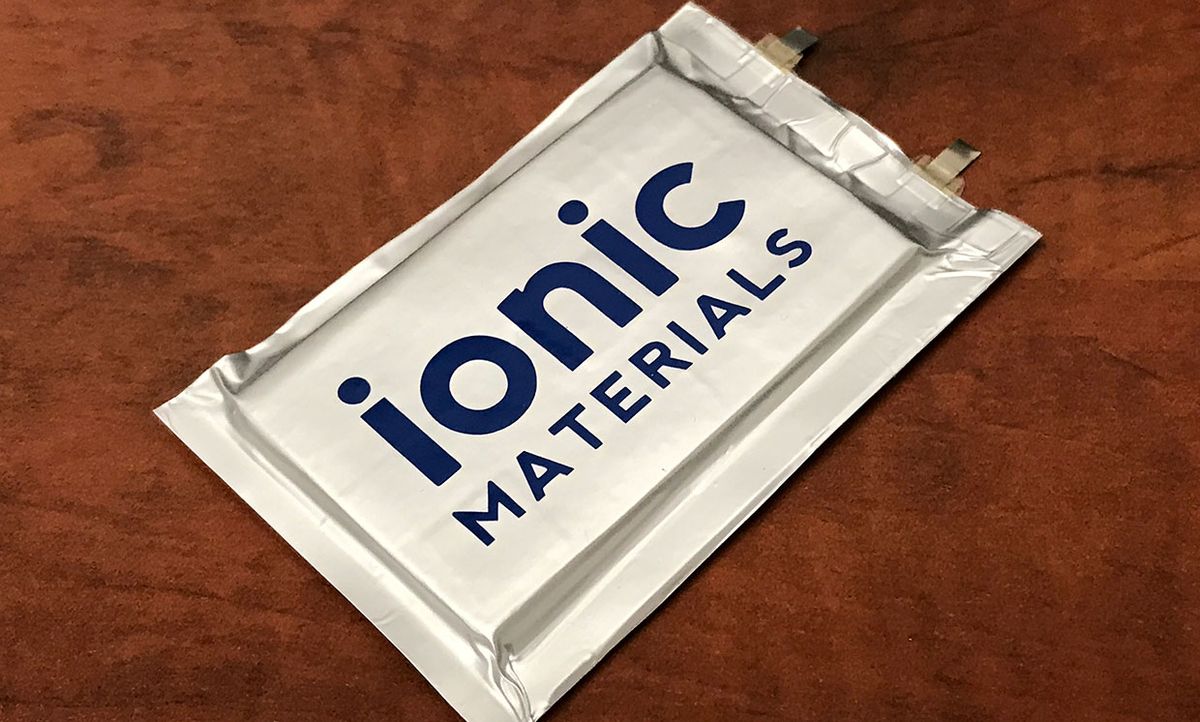Better batteries for electric cars and grid-energy storage may be just one revolution away—whether in fuel cells or flow batteries or supercapacitors. But there’s a company in Massachusetts that’s betting the evolution of existing technology—rather than a revolution—will determine how we power future EVs and store renewable energy.
“Lithium ion has this massive scale,” says Erik Terjesen, senior director of licensing and strategy for Ionic Materials, based in the city of Woburn. “The people who build lithium-ion factories—the LGs, the CATLs of the world—are building massive capacity for lithium-ion.” These billions of dollars already invested, Terjesen says, represent inertia that will resist revolutionary new battery technologies—especially if lithium technology can offer more energy storage, safer products, lower prices, and be made in existing factories.
As IEEE Spectrum profiled in 2018, Ionic Materials is developing a plastic, solid-state electrolyte to sit between a rechargeable battery’s anode and cathode. The electrolyte acts as the conduction medium through which lithium ions flow from anode to cathode and back again—providing the basis for many charge-discharge cycles in the battery’s lifetime.
The most effective and resilient electrolytes in lithium-ion batteries to date have been liquids, which conduct ions well but do nothing to keep the cathode and anode from ever touching. This has been the job of a thin plastic membrane with tiny micrometer-sized holes in it called the separator, which allows lithium ions to pass through.
The problems come when there are manufacturing defects, tears in the separator, a puncture in the battery, or a growth of stalactite-like “dendrites” bridging cathode and anode through the separators. In all those cases, a short circuit could result. That is where the other downside of the liquid electrolyte comes in: It’s highly flammable. Which is why there have been reports of the (rare) exploding laptop, smartphone, and EV.
Ionic Materials’ solid-state electrolyte is, of course, its own separator. And it’s nonflammable.
“From the dialogues we’re having with electric vehicle OEMs, it’s exciting for them to have an inherently safe battery in their cars that works in the same way,” Terjesen says. “We’re not talking about a new design. We’re not talking about a new cell format. It fits into their world today.”
Since 2018, Terjesen says, the company has been establishing partnerships and announcing investors, including the French oil and gas company Total, A123 Systems, Dyson, Samsung, Renault-Nissan-Mitsubishi, and Volta Energy Technologies.
“We are aware of the fact that there is obviously a lot of hype that comes with the battery industry in general,” Terjesen says. “So our CEO Mike Zimmerman says you really need to prove what you’re saying, rather than just making claims.”
The areas the company is now most carefully investigating around their polymer electrolyte, he says, are safety, energy density, and cost.
The first two, he says, go hand in hand. The greater a battery’s energy density, the more the electrolyte’s safety matters. “We think our polymer can work with more energy-dense anode and cathode combinations,” he says. “As people try to squeeze all the energy they can out of these cells, by default, the cell will become more volatile. We think the safety question will only continue to increase as you look at these higher-energy chemistries.”
The question of price, Terjesen says, is also important. In 2010, the industry produced batteries costing some US $1,200 per kilowatt-hour. By 2014, that price had fallen to $600/kWh. As of last year, it was south of $200/kWh. And now, Terjesen says, many industry players are trying to get below $100/kWh. (Ionic Materials does not release data on its cost or ability to enable battery companies to drive their unit cost down.)
“Getting below [$100/kWh] will be challenging, because the fundamental materials themselves are commodities. And the raw materials themselves have a certain price,” he says.
For instance, cobalt is both expensive and controversial, with much of its global reserves found in the Democratic Republic of the Congo—where corruption and disputed labor practices have led Elon Musk to swear off the mineral in Tesla’s future-generation cars.
“We’ve learned that cobalt is often used in these cells as a stabilizing agent,” Terjesen says. “So if we can create greater safety with our material, it opens the door for the potential to reduce or eliminate the cobalt.”
However, Terjesen says Ionic Materials is ultimately chemistry-agnostic. They do not even build batteries. The company only provides the solid-state electrolyte for battery makers to develop whatever next-generation solid-state batteries the market will bear.
“There isn’t a single chemistry that we’re betting on,” he says. “We’re not going to the market and saying—you have to do this chemistry or that chemistry. We have multiple chemistries that we’re working on with multiple partners with our polymer.”
In other words, Ionic Materials is trying not to disrupt an industry accustomed to disruption.
“Most people who look at solid-state [batteries] think, it’s not a disruptor of lithium ions,” Terjesen says. “It’s the next phase of lithium ions."
Margo Anderson is senior associate editor and telecommunications editor at IEEE Spectrum. She has a bachelor’s degree in physics and a master’s degree in astrophysics.



